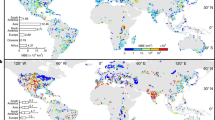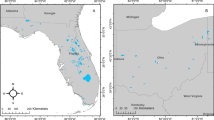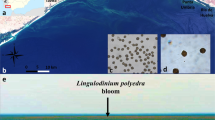Abstract
Many regions of the Great Lakes now see recurring cyanobacterial harmful algal blooms (cyanoHABs), with documented repercussions for ecosystem services, public health, and ecosystem integrity. Early detection and comprehensive monitoring of cyanoHABs are fundamental to their effective management and mitigation of detrimental impacts. Satellite remote sensing has provided the means by which algal blooms in the Great Lakes can be observed with unprecedented frequency and spatial coverage. Algorithms have been developed and validated; fully automated data processing streams have been rendered operational; and stakeholders have been engaged in order to develop user-friendly end products. Such products have been integral in providing near-real-time monitoring of bloom conditions, documenting spatiotemporal trends, improving understanding of environmental drivers of blooms, and guiding nutrient management actions. In this chapter we present background information on remote sensing of algal blooms, document the current state of knowledge with a focus on Lake Erie, and discuss remote sensing products available to the Great Lakes community.
Access this chapter
Tax calculation will be finalised at checkout
Purchases are for personal use only
Similar content being viewed by others
References
Sydor M, Stortz KR, Swain WR (1978) Identification of contaminants in Lake Superior through Landsat I data. J Great Lakes Res 4(2):142–148
Strong AE (1978) Chemical whitings and chlorophyll distributions in the Great Lakes as viewed by Landsat. Remote Sens Environ 7(1):61–72
Harris GP, Bukata RP, Bruton JE (1974) Satellite observations of water quality. ASCE Trans Eng J 102(3):537–554
Ho JC, Michalak AM (2017) Phytoplankton blooms in Lake Erie impacted by both long-term and springtime phosphorus loading. J Great Lakes Res 43:221–228
Mckindles K, Frenken T, McKay RM, Bullerjahn GS (2020) Binational efforts addressing cyanobacterial harmful algal blooms in the Great Lakes. In: Crossman J, Weisener C (eds.) Contaminants of the Great Lakes. The handbook of environmental chemistry. Springer, Berlin, Heidelberg
Stumpf RP, Wynne TT, Baker DB, Fahnenstiel GL (2012) Interannual variability of cyanobacterial blooms in Lake Erie. PLoS One 7(8):e42444
Vanderploeg HA, Liebig JR, Carmichael WW, Agy MA, Johengen TH, Fahnenstiel GL, Nalepa TF (2001) Zebra mussel (Dreissena polymorpha) selective filtration promoted toxic 891 Microcystis blooms in Saginaw Bay (Lake Huron) and Lake Erie. Can J Fish Aquat Sci 58:1208–1221
Bridgeman TB, Chaffin JD, Filbrun JE (2013) A novel method for tracking western Lake Erie Microcystis blooms, 2002–2011. J Great Lakes Res 39(1):83–89
Dove A, Chapra SC (2015) Long-term trends of nutrients and trophic response variables for the Great Lakes. Limnol Oceanogr 60:696–721
Stumpf RP, Johnson LT, Wynne TT, Baker DB (2016) Forecasting annual cyanobacterial bloom biomass to inform management decisions in Lake Erie. J Great Lakes Res 42(6):1174–1183
Wynne TT, Stumpf RP, Tomlinson MC, Fahnenstiel GL, Dyble J, Schwab DJ, Joshi SJ (2013) Evolution of a cyanobacterial bloom forecast system in western Lake Erie: development and initial evaluation. J Great Lakes Res 39(S1):90–99
Dekker A, Hestir E, Wang M, Matthews M, Spyrakos E (2018) Chapter 6 in: IOCCG (2018). Earth observations in support of global water quality monitoring. In: Greb S, Dekker A, Binding C (eds) IOCCG report series, no. 17. International Ocean Colour Coordinating Group, Dartmouth
Mouw CB, Greb S, Aurin D, DiGiacomo PM, Lee Z, Twardowski M, Binding C, Hu C, Ma R, Moore T, Moses W, Craig SE (2015) Aquatic color radiometry remote sensing of coastal and inland waters: challenges and recommendations for future satellite missions. Remote Sens Environ 160:15–30
Binding CE, Greenberg TA, Watson SB, Rastin S, Gould J (2015) Long term water clarity changes in North America’s Great Lakes from multi-sensor satellite observations. Limnol Oceanogr 60(6):1976–1995
Sayers MJ, Grimm AG, Shuchman RA, Bosse KR, Fahnenstiel GL, Ruberg SA, Leshkevich GA (2019) Satellite monitoring of harmful algal blooms in the Western Basin of Lake Erie: a 20-year time-series. J Great Lakes Res 45(3):508–521
Wynne TT, Stumpf RP, Briggs TO (2013) Comparing MODIS and MERIS spectral shapes for cyanobacterial bloom detection. Int J Remote Sens 34(19):6668–6678
Zeng C, Binding CE (2019) Simulation of mineral sediment impacts on red-NIR algorithms for inland water chlorophyll retrievals. Remote Sens 11(19):2306
Becker RH, Sultan MI, Boyer GL, Twiss MR, Konopko E (2009) Mapping cyanobacterial blooms in the Great Lakes using MODIS. J Great Lakes Res 35(3):447–453
Lesht BM, Barbiero RP, Warren GJ (2013) A band-ratio algorithm for retrieving openlake chlorophyll values from satellite observations of the Great Lakes. J Great Lakes Res 39(1):138–152
Wynne TT, Stumpf RP, Tomlinson MC, Dyble J (2010) Characterizing a cyanobacterial bloom in western Lake Erie using satellite imagery and meteorological data. Limnol Oceanogr 55:2025–2036
Shuchman RA, Leshkevich G, Sayers MJ, Johengen TH, Brooks CN, Pozdnyakov D (2013) An algorithm to retrieve chlorophyll, dissolved organic carbon, and suspended minerals from Great Lakes satellite data. J Great Lakes Res 39(S1):14–33
Sayers M, Fahnenstiel GL, Shuchman RA, Whitley M (2016) Cyanobacteria blooms in three eutrophic basins of the Great Lakes: a comparative analysis using satellite remote sensing. Int J Remote Sens 37(17):4148–4171
Binding CE, Greenberg TA, Bukata RP (2012) An analysis of MODIS-derived algal and mineral turbidity in Lake Erie. J Great Lakes Res 38(1):107–116
Binding CE, Zastepa A, Zeng C (2019) The impact of phytoplankton community composition on optical properties and satellite observations of the 2017 western Lake Erie algal bloom. J Great Lakes Res 45(3):573–586
Ortiz JD, Witter DL, Ali KA, Fela N, Duff M, Mills L (2013) Evaluating multiple colour-producing agents in case II waters from Lake Erie. Int J Remote Sens 34:8854–8880
Doerffer R, Schiller H (2007) The MERIS case 2 water algorithm. Int J Remote Sens 28(3-4):517–535
O’Reilly JE, Werdell PJ (2019) Chlorophyll algorithms for ocean color sensors – OC4, OC5 & OC6. Remote Sens Environ 229:32–47
Bukata RP, Jerome JH, Kondratyev KY, Pozdnyakov DV (1995) Optical properties and remote sensing of inland and coastal waters. CRC Press, Boca Raton
Budd JW, Warrington DS (2004) Satellite-based sediment and chlorophyll a estimates for Lake Superior. J Great Lakes Res 30:459–466
Witter DL, Ortiz JD, Palm S, Heath RT, Budd JW (2009) Assessing the application of SeaWiFS Ocean color algorithms to Lake Erie. J Great Lakes Res 35(3):361–370
Ali K, Witter D, Ortiz J (2014) Application of empirical and semi-analytical algorithms to MERIS data for estimating chlorophyll a in case 2 waters of Lake Erie. Environ Earth Sci 71(9):4209–4220
Gilerson AA, Gitelson AA, Zhou J, Gurlin D, Moses W, Ioannou I, Ahmed SA (2010) Algorithms for remote estimation of chlorophyll-a in coastal and inland waters using red and near infrared bands. Opt Express 18(23):24109–24125
Binding CE, Greenberg TA, McCullough G, Watson SB, Page E (2018) An analysis of satellite-derived chlorophyll and algal bloom indices on Lake Winnipeg. J Great Lakes Res 44(3):436–446
Wynne TT, Stumpf RP, Tomlinson MC, Warner RA, Tester PA, Dyble J, Fahnenstiel GL (2008) Relating spectral shape to cyanobacterial blooms in the Laurentian Great Lakes. Int J Remote Sens 29(12):3665–3672
Simis SGH, Peters SWM, Gons HJ (2005) Remote sensing of the cyanobacterial pigment phycocyanin in turbid inland water. Limnol Oceanogr 50(1):237–245
Yacobi YZ, Köhler J, Leunert F, Gitelson A (2015) Phycocyanin-specific absorption coefficient: eliminating the effect of chlorophylls absorption. Limnol Oceanogr Methods 13(4):157–168
Simis SGH, Ruiz-Verdú A, Domínguez-Gómez JA, Peña-Martinez R, Peters SWM, Gons HJ (2007) Influence of phytoplankton pigment composition on remote sensing of cyanobacterial biomass. Remote Sens Environ 106(4):414–427
Ruiz-Verdú A, Simis SGH, de Hoyos C, Gons HJ, Peña-Martínez R (2008) An evaluation of algorithms for the remote sensing of cyanobacterial biomass. Remote Sens Environ 112(11):3996–4008
Stumpf RP, Davis TW, Wynne TT, Graham JL, Loftin KA, Johengen TH, Gossiaux D, Palladino D, Burtner A (2016) Challenges for mapping cyanotoxin patterns from remote sensing of cyanobacteria. Harmful Algae 54:160–173
Matthews MW, Bernard S, Robertson L (2012) An algorithm for detecting trophic status (chlorophyll-a), cyanobacterial-dominance, surface scums and floating vegetation in inland and coastal waters. Remote Sens Environ 124:637–652
Lunetta RS, Schaeffer BA, Stumpf RP, Keith D, Jacobs SA, Murphy MS (2015) Evaluation of cyanobacteria cell count detection derived from MERIS imagery across the eastern USA. Remote Sens Environ 157:24–34
Tomlinson MC, Stumpf RP, Wynne TT, Dupuy D, Burks R, Hendrickson J, Fulton III RS (2016) Relating chlorophyll from cyanobacteria-dominated inland waters to a MERIS bloom index. Remote Sens Lett 7(2):141–149
Vincent RK, Qin X, McKay RML, Miner J, Czajkowski K, Savino J, Bridgeman T (2004) Phycocyanin detection from LANDSAT TM data for mapping cyanobacterial blooms in Lake Erie. Remote Sens Environ 89(3):381–392
Ho JC, Stumpf RP, Bridgeman TB, Michalak AM (2017) Using Landsat to extend the historical record of lacustrine phytoplankton blooms: a Lake Erie case study. Remote Sens Environ 191:273–285
Wang G, Lee Z, Mouw C (2017) Multi-spectral remote sensing of phytoplankton pigment absorption properties in cyanobacteria bloom waters: a regional example in the Western Basin of Lake Erie. Remote Sens 9(12):1309
Avouris DM, Ortiz JD (2019) Validation of 2015 Lake Erie MODIS image spectral decomposition using visible derivative spectroscopy and field campaign data. J Great Lakes Res 45(3):466–479
MTRI (2019) https://greatlakesremotesensing.org/
Urquhart EA, Schaeffer BA, Stumpf RP, Loftin KA, Werdell PJ (2017) A method for examining temporal changes in cyanobacterial harmful algal bloom spatial extent using satellite remote sensing. Harmful Algae 67:144–152
Clark JM, Schaeffer BA, Darling JA, Urquhart EA, Johnston JM, Ignatius A, Myer MH, Loftin KA, Werdell PJ, Stumpf RP (2017) Satellite monitoring of cyanobacterial harmful algal bloom frequency in recreational waters and drinking source waters. Ecol Indic 80:84–95
Wynne TT, Stumpf RP (2015) Spatial and temporal patterns in the seasonal distribution of toxic cyanobacteria in western Lake Erie from 2002–2014. Toxins 7(5):1649–1663
GLWQA, Annex 4 (2015) Recommended phosphorus loading targets for Lake Erie, annex 4 objectives and targets task team final report to the nutrients annex subcommittee, 70 p. http://www.epa.gov/glwqa
Bertani I, Steger CE, Obenour DR, Fahnenstiel GL, Bridgeman TB, Johengen TH, Sayers MJ, Shuchman RA, Scavia D (2017) Tracking cyanobacteria blooms: do different monitoring approaches tell the same story? Sci Total Environ 575:294–308
Obenour D, Gronewold A, Stow C, Scavia D (2014) Using a Bayesian hierarchical model to improve Lake Erie cyanobacteria bloom forecasts. Water Resour Res 50(10):7847–7860
Soontiens N, Binding C, Fortin V, Mackay M, Rao YR (2019) Algal bloom transport in Lake Erie using remote sensing and hydrodynamic modelling: sensitivity to buoyancy velocity and initial vertical distribution. J Great Lakes Res 45(3):556–572
Chorus I, Bartram J (1999) Toxic cyanobacteria in water: a guide to their public health consequences, monitoring and management. E & FN Spon, London
Davis TW, Stumpf R, Bullerjahn GS, McKay RML, Chaffin JD, Bridgeman TB, Winslow C (2019) Science meets policy: a framework for determining impairment designation criteria for large waterbodies affected by cyanobacterial harmful algal blooms. Harmful Algae 81:59–64
Mishra S, Stumpf RP, Schaeffer BA, Werdell PJ, Loftin KA, Meredith A (2019) Measurement of cyanobacterial bloom magnitude using satellite remote sensing. Sci Rep 9:18310
Kahru M, Savchuk OP, Elmgren R (2007) Satellite measurements of cyanobacterial bloom frequency in the Baltic Sea: interannual and spatial variability. Mar Ecol Prog Ser 343:15–23
Kutser T, Metsamaa L, Strömbeck N, Vahtmäe E (2006) Monitoring cyanobacterial blooms by satellite remote sensing. Estuar Coast Shelf Sci 67:303–312
Reinart A, Kutser T (2006) Comparison of different satellite sensors in detecting cyanobacterial bloom events in the Baltic Sea. Remote Sens Environ 102:74–85
Moreno-Ostos E, Cruz-Pizarro L, Basanta A (2009) The influence of wind-induced mixing on the vertical distribution of buoyant and sinking phytoplankton species. Aquat Ecol 43:271–284
Gordon HR, McCluney WR (1975) Estimation of the depth of sunlight penetration in the sea for remote sensing. Appl Opt 14(2):413–416
Binding CE, Greenberg TA, Jerome JH, Bukata RP, Letourneau G (2011) An assessment of MERIS algal products during an intense bloom in Lake of the Woods. J Plankton Res 33(5):793–806
Bosse KR, Sayers MJ, Shuchman RA, Fahnenstiel GL, Ruberg SA, Fanslow DL, Stuart DG, Johengen TH, Burtner AM (2019) Spatial-temporal variability of in situ cyanobacteria vertical structure in Western Lake Erie: implications for remote sensing observations. J Great Lakes Res 45(3):480–489
Kutser T, Metsamaa L, Dekker AG (2008) Influence of the vertical distribution of cyanobacteria in the water column on the remote sensing signal. Estuar Coast Shelf Sci 78(4):649–654
Rowe M, Anderson E, Wynne T, Stumpf R, Fanslow D, Kijanka K, Vanderploeg H, Strickler J, Davis T (2016) Vertical distribution of buoyant Microcystis blooms in a Lagrangian particle tracking model for short-term forecasts in Lake Erie. J Geophys Res Oceans 121:5296–5314
Moore TS, Churnside JH, Sullivan JM, Twardowski MS, Nayak AR, McFarland MN, Stockley ND, Gould RW, Johengen TH, Ruberg SA (2019) Vertical distributions of blooming cyanobacteria populations in a freshwater lake from LIDAR observations. Remote Sens Environ 225:347–367
Moore TS, Mouw CB, Sullivan JM, Twardowski MS, Burtner AM, Ciochetto AB, McFarland MN, Nayak AR, Paladino D, Stockley ND, Johengen TH, Yu AW, Ruberg S, Weidemann A (2017) Bio-optical properties of cyanobacteria blooms in western Lake Erie. Front Mar Sci 4(SEP):300
Sayers MJ, Bosse KR, Shuchman RA, Ruberg SA, Fahnenstiel GL, Leshkevich GA, Stuart DG, Johengen TH, Burtner AM, Palladino D (2019) Spatial and temporal variability of inherent and apparent optical properties in western Lake Erie: implications for water quality remote sensing. J Great Lakes Res 45(3):490–507
Matthews MW, Bernard S (2013) Using a two-layered sphere model to investigate the impact of gas vacuoles on the inherent optical properties of Microcystis aeruginosa. Biogeosciences 10(12):8139–8157
Paerl HW, Ustach JF (1982) Blue-green algal scums: an explanation for their occurrence during freshwater blooms. Limnol Oceanogr 27(2):212–217
Stomp M, Huisman J, Vörös L, Pick FR, Laamanen M, Haverkamp T, Stal LJ (2007) Colourful coexistence of red and green picocyanobacteria in lakes and seas. Ecol Lett 10(4):290–298
Author information
Authors and Affiliations
Corresponding author
Editor information
Editors and Affiliations
Rights and permissions
Copyright information
© 2020 Springer Nature Switzerland AG
About this chapter
Cite this chapter
Binding, C.E., Stumpf, R.P., Shuchman, R.A., Sayers, M.J. (2020). Advances in Remote Sensing of Great Lakes Algal Blooms. In: Crossman, J., Weisener, C. (eds) Contaminants of the Great Lakes. The Handbook of Environmental Chemistry, vol 101. Springer, Cham. https://doi.org/10.1007/698_2020_589
Download citation
DOI: https://doi.org/10.1007/698_2020_589
Published:
Publisher Name: Springer, Cham
Print ISBN: 978-3-030-57873-2
Online ISBN: 978-3-030-57874-9
eBook Packages: Chemistry and Materials ScienceChemistry and Material Science (R0)




